I often get asked by business owners on how they should go about making a sales plan for their business. My 10 plus years experience in doing this for large corporates and for many small business owners is something I want to share with the world.
I am writing this article more like a thesis and to serve as a practical guide for anyone who wants to learn how to do sales planning. I will go into a lot of detail sharing specifics about how i do it and adding my views on what is the better way of doing sales planning and what works.
Sales planning is a critical ‘thinking muscle’ that any business must have. Without the right approach to sales planning, many businesses often don’t know what they are capable of.
For a mature organization, sales planning has evolved into something known as Integrated business planning, where the sales plan is the seed, which helps drive the plans for other functions and also covers aspects such as budgeting, operational expenses etc for the full company.
A good sales plan, can serve as an execution document, a company wide goal setting exercise and a guide to measure progress versus plan for the business. A well constructed sales plan helps a small business understand where things are going wrong and what can be done to fix them.
A sales plan also helps a business owner measure the actual outcomes versus the assumptions taken while going into the plan.
Why sales planning is critical for a small business that is looking for growth

There are 6 main reasons why sales planning is critical for a small business that is looking to grow. Lets go into the details of these and understand why they are so critical for a small business owner.
- Accounts for all your resources: A sales plan basically needs you to account for your resources, in terms of number of people that you have, the enabling tools they will need, the expenses they will incur, the marketing support they will need and how efficiently these resources are able to deliver
- Put all assumptions in a structured form: Any business will have a set of assumptions to work with at the beginning. The sales plan will bake in these assumptions at each stage. This is needed as once you execute and see the outcomes, you can tweak future plans to reflect the actual picture
- You can play out multiple scenarios: A sales plan will help you forecast multiple scenarios for your business. For example, if your star sales person leaves, you will be able to estimate the loss of sales for your business. Similarly, you will also be able to see the gap in productivity between average performers and top performers as you progress when compared with the sales plan.
- Your sales plan can become your business plan: A sales plan is often the core of any business plan for a company since it details how the company plans to generate revenue. Making a well structured sales plan get 75% of the work of making a business plan done. This especially important if your business is going to seek funding in the near future.
- A sales plan helps keep the team aligned: Once you have your sales plan put-together, you will be able to communicate with full clarity on what each person on the team is expected to deliver. This will keep your teams aligned on their objectives and they will know the impact they are creating for the business.
- A sales plan is necessary for you to take strategic calls: Your sales plan will tell you how much revenue you should be aiming for in the subsequent period. It will tell you by how much you will either exceed or fall short. These measures will enable you to take strategic calls like entering into a new partnership, signing up for a new loan, selling a part of your business and many others.
As a small business, having understood the impact that a sales plan has on your business, its important that you learn the essential elements that go into making a sales plan for your business.
By following the steps and thought process outlined in the next few sections, you will be in a position to start implementing the right sales plan for your business.
Elements of a sales plan that every small business should include in their sales strategy
Every sales plan should have the following four elements factored in. These elements are some of the key levers that are available to a business owner to move their business in a strategic direction.
- Sales funnel: Every business owner must think through a sales funnel that is suitable for their business and build out the stages of the sales funnel. A sales funnel is essentially the mental journey the customer takes while buying a product from the customer.
- Sales Conversion rates: This essentially how many customers move from one stage of your sales funnel into the next stage expressed as a percentage. A business owner must have a good understanding of sales conversion rates and how to improve them.
- Productivity assumptions of inputs: These are all the assumptions that you make about how much of work needs to be put in by a sales agent to get one sale. It can be metrics like phone calls made, customer meetings done, product demo’s done etc. A business owner must be prepared with all the key input metrics that matter for his business.
- A high level objective: This basically answering what you want to achieve in the given period. It can be an X% growth rate quarter over quarter, or a fixed revenue target or a fixed sales target or it can be an end state of the marketshare you want to achieve. My personal recommendation is that business owners must look at finding a fixed revenue target as the objective.
In order to incorporate these elements into a sales plan, a small business owner will have take some time to review the past sales data. Look for trends, averages, top 10 percentile performance and bottom quartile performance.
In addition to your own data, look at the overall industry sector and how that has progressed. Look for overall growth, look for individual companies (large ones and small ones) where the data is available to gauge their growth rates.
If the industrial sector is growing every year for the past few years, as a small business owner, you should look at growing at least 2X as faster to keep your business running. If other businesses are growing faster than the sector average, then there is consolidation happening where large businesses gain market share.
Step by step process for implementing a sales plan as a small business owner

Through the next several sections, I will outline the process that I have refined over the many years where I led the integrated business planning function at multi-national companies.
As a thumb rule, every business owner should look at the business both from a top-down or an outside-in perspective as well as from a bottom-up or inside-out perspective.
When you do this, you are well positioned to have two perspectives which will give you a good sense of what kind of sales targets you should be setting and how you can go about it.
The broad idea is to find a common ground between the outside-in or top-down approach and the bottom-up approach so that you keep your ambitions realistic as well as you sweat your resources efficiently
In order to do this exercise, lets look at the entire sales planning cycle through an example of a product that a small business owner has. For the benefit of everyone, lets assume that the product to be sold is a software in the business and accounting space.
Lets also assume that the small business owner is located in the state of Texas to make it practical.
The reason I chose this product and location is simply because there is scope to cover all kinds of sales processes here and build a plan around them.
Top-Down sales plan: What is it and when to use it

A Top Down sales plan is arriving at a plan for your business to achieve a certain position in the market. Its the Outside-In approach where you benchmark performance that you need to achieve based on the market opportunities and other players in the market.
A top down sales plan looks at the following factors for arriving at the reasonable share of the market a business should achieve over a period of time
- The estimated total addressable market (TAM) which is the max potential of the market
- The section of the market which really needs your product or services – serviceable addressable market (SAM)
- The share of market that you can really achieve – Serviceable and Obtainable market (SOM)
- Industry trends and reports – predicting size of the market, growth rate
- Investment and VC repots – how much money is being invested in the market today and in the foreseeable future
Now in our example, if we look at the accounting and software space in Texas, we can get some good information from the overall market trends and other research reports.
Pre-requisites for a top-down sales plan
For the top-down sales plan, we need to first start with the following set of details for an accounting product. Lets look at all the data points that a business owner should look at

- Look at the overall number of small businesses in Texas as a state, identify the city wise breakup of all of these
- From the identified markets, you will have to look at where you can go with your current resources and prioritise your market
- Once you know exactly where you can go, and how many customers you have, you need to look at the %of the customers you can acquire
Once you have this action plan to approach your market, you need to look at what the market penetration will give and what is required with respect to resources.
In the same example, look at Houston as the first market you want to enter where your target customer is almost 20% of all the small businesses in Texas where you have a target penetration of say 30%
This means that you will deploy resources to acquire 30% of the customers in Houston over a period of time. This can be the first year or the first couple of years depending on the speed with which you want to grow.
Acquiring 30% of Houston’s market will mean that you will need to. acquire at least 30,000 small businesses. Now in order to acquire 30,000 small businesses, it not sufficient to just reach out 30,000. You will have to reach out to at least 90,000 small businesses so that at least 1/3rd of them remember you when you re-target them.
What this means is that you will need to factor in resources to at least touch 3X of the target customers that you want to acquire.
If you are tight in terms of resourcing and are quite apprehensive about attempting scale quickly, settle for a much lower market penetration level initially which will bring down the customer touch points to a manageable level initially.
What this could drive is for you to lock into a specific geography to attempt an outreach instead of targeting the entire city of Houston.
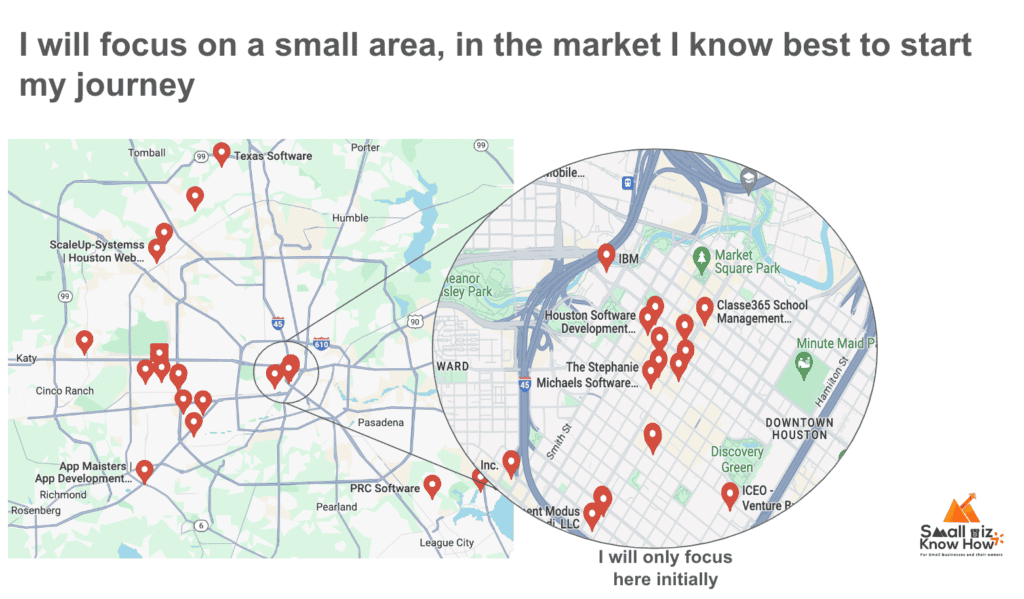
Bottom Up sales plan: Why every small business owner must get their team to learn this process
Once you have first identified where you are going to play, the next step is to build an execution plan with a bottom up sales plan.
A Bottom-Up Sales Plan involves building a sales strategy starting from the individual contributor level up to the overarching business goals.
This method allows for granular insights and realistic expectations because it factors in the actual capacities and limitations of the sales team.
This approach looks at many individual factors such as prior sales experience, the ability to generate leads or demand generation, the number of meetings each person can do, the number of actual meetings that convert into product demos and the number of product demos that actually convert into sales
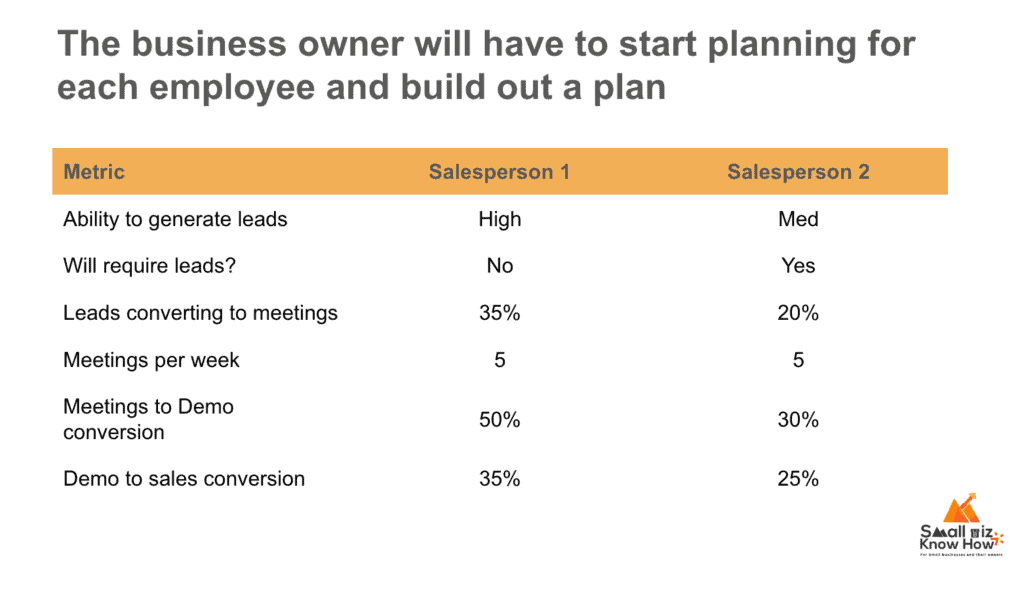
For small business owners, teaching their team this approach ensures that every member understands their direct impact on the company’s success, fostering a sense of accountability and motivation.
Pre-requisites for a bottom up sales plan
A business owner must have an idea of the team and their capabilities, even if it is for a short period of time that the team has been together. The business owner must also have visibility into the kind of numbers that his or her business has been clocking.
- Detailed Understanding of Individual Capabilities: Knowing the strengths and weaknesses of each team member to set realistic sales targets.
- Clear Communication Channels: Ensuring information flows efficiently between team members and management.
- Access to Sales Data: Team members need access to historical performance data to analyze and learn from past outcomes.
Team Dynamics and Capabilities: Understanding your team goes beyond just knowing their strengths and weaknesses. It involves grasping the dynamics between team members, their interpersonal skills, and how they collaborate.
A cohesive team that communicates well and leverages each other’s strengths can achieve far more than a group of individuals working in silos. Additionally, recognizing the potential for growth and development within the team can guide you in setting realistic yet challenging sales targets.
It’s not just about what they can do now, but also about nurturing their potential for future success.
Clear Communication Channels: Effective communication is the lifeblood of any successful sales strategy. Beyond just ensuring information flows efficiently, it’s about fostering a culture of open dialogue and feedback.
This means not only top-down communication from management to team members but also encouraging bottom-up feedback where team members can share insights, challenges, and ideas.
Creating a feedback loop ensures that everyone is aligned with the goals and strategies, leading to more informed decision-making and adaptability in a dynamic market environment.
Access to Comprehensive Sales Data: Providing your team with access to historical performance data is crucial for informed decision-making and continuous improvement. However, it’s not just about giving them access to raw numbers. It’s about empowering them with the tools and knowledge to interpret and derive actionable insights from that data.
This could involve training on data analysis tools, regular reviews and discussions on performance metrics, and encouraging a data-driven mindset within the team.
When team members understand the story behind the numbers and how their actions impact overall performance, they are better equipped to make strategic decisions and optimize their sales approach.
Bottom up sales planning for a field sales team: Setting goals for sales team members

- Individual Goal Setting: Each salesperson’s targets should align with their past performance and future potential improvement.
- Territory management: Each salesperson must have a defined territory where he or she is the only one responsible for all target customers in that area. Territories must not overlap. A good practice is to divide territories based on the postal code of the region since it becomes an objective criteria to track leads and followups easily and with accountability.
- Regular Feedback: Incorporate continuous feedback loops where sales strategies are adjusted based on ground-level realities and client interactions.
- Incentive Structures: Design incentives that motivate not only reaching targets but also innovative ways of customer engagement.
- Lead requirements: For every individual, who is out there on the field, the demand generation process is unique. Many sales specialists do their own demand generation and are very successful at it, whereas many require the organisation’s marketing teams to deliver on the leads which they then pursue. Both approaches will have different resource requirements. Typically, salespeople who can generate their own set of leads are highly skilled and tend to command a higher value in the market.
Depending on what you choose to implement, your planning process will change slightly since the KPIs you will measure are very different for both processes.
You will want to look at how many demos a salesperson can complete in a month when he or she sources their own leads, whereas you may want to look at how many meetings are actually happening when you are providing leads.
My opinion is that as a small business, you must give the freedom to your sales teams to acquire leads on their own and hold them accountable to actual revenue outcomes. As your business grows and you have the resources, progress towards building a marketing engine that can also support the sales team on the ground with required leads.
Bottom up sales planning for a remote sales team (tele-sales)

If you choose to invest in a remote sales team, you will have to build a funnel thoughtfully and track them very closely. In today’s age where people in general consider unsolicited phone calls a nuisance, remote or telesales is seeing a stagnation in conversion rates and the cost of acquiring a customer has gone up.
- Virtual Training Sessions: To equip the team with best practices and product knowledge.
- Robust CRM Tools: Use CRM software to track customer interactions and sales progress.
- Daily Check-ins: Foster a sense of team unity and continuous alignment with company goals.
Team Dynamics and Capabilities: Understanding your team goes beyond just knowing their strengths and weaknesses. It involves grasping the dynamics between team members, their interpersonal skills, and how they collaborate.
A cohesive team that communicates well and leverages each other’s strengths can achieve far more than a group of individuals working in silos. Additionally, recognizing the potential for growth and development within the team can guide you in setting realistic yet challenging sales targets.
It’s not just about what they can do now, but also about nurturing their potential for future success.
Clear Communication Channels: Effective communication is the lifeblood of any successful sales strategy. Beyond just ensuring information flows efficiently, it’s about fostering a culture of open dialogue and feedback.
This means not only top-down communication from management to team members but also encouraging bottom-up feedback where team members can share insights, challenges, and ideas.
Creating a feedback loop ensures that everyone is aligned with the goals and strategies, leading to more informed decision-making and adaptability in a dynamic market environment.
Access to Comprehensive Sales Data: Providing your team with access to historical performance data is crucial for informed decision-making and continuous improvement. However, it’s not just about giving them access to raw numbers.
It’s about empowering them with the tools and knowledge to interpret and derive actionable insights from that data. This could involve training on data analysis tools, regular reviews and discussions on performance metrics, and encouraging a data-driven mindset within the team.
When team members understand the story behind the numbers and how their actions impact overall performance, they are better equipped to make strategic decisions and optimize their sales approach.
Bottom up sales planning for a digital marketing campaign – How marketing drives sales
- Lead Generation: Digital marketing efforts should focus on generating high-quality leads that are more likely to convert into sales.
- Content Strategy: Develop content that addresses customer pain points, leading them down the sales funnel.
- Metrics Tracking: Monitor campaign performance and adjust strategies in real-time based on data-driven insights.
Lead Generation: Lead generation in digital marketing isn’t just about acquiring contacts; it’s about nurturing relationships with potential customers.
Personalizing your approach can make a significant impact. For instance, I once worked with a small business where we tailored our lead generation efforts based on customer behavior data. By analyzing which content attracted the most engagement, we refined our strategies to target similar audiences more effectively.
This not only increased lead quality but also improved conversion rates as we were engaging with prospects who were already interested in our offerings.
Content Strategy: A successful digital marketing campaign hinges on compelling content that resonates with your target audience. Beyond simply creating content, it’s about crafting a narrative that addresses customer pain points and provides solutions.
I recall a project where we conducted in-depth customer interviews to understand their challenges thoroughly. This insight guided our content strategy, allowing us to create valuable resources such as whitepapers, case studies, and how-to guides that directly addressed our audience’s needs.
basically, this approach not only drove engagement but also positioned our brand as a trusted advisor in the industry, ultimately driving sales.
Metrics Tracking: The beauty of digital marketing lies in its measurability. Tracking key metrics allows for real-time optimization and agility in campaign management.
One memorable experience was when we launched a digital marketing campaign for a new product. Through continuous monitoring of metrics like click-through rates, conversion rates, and cost per acquisition, we identified areas for improvement early on.
By swiftly adjusting our targeting, messaging, and ad placements based on these insights, we were able to optimize our campaign performance and maximize ROI.
How to make sure your bottom up plan works: Learn what can scale and what cannot
- Scalability Testing: Regularly test different sales processes to identify which can be scaled up without loss of effectiveness.
- Feedback Loops: Establish strong feedback mechanisms to continuously learn from the sales team’s experiences and customer interactions.
- Resource Evaluation: Regularly assess whether the infrastructure, from software tools to team capabilities, can handle expanded operations.
Scalability Testing: Scalability is not just about increasing volume but maintaining effectiveness as operations expand. One notable example of scalability testing is Amazon’s approach to their e-commerce platform.
They continuously test and optimize various sales processes, from checkout workflows to personalized product recommendations.
By analyzing data on user behavior and sales performance, they identify what can scale seamlessly while delivering a consistent and positive customer experience. This iterative approach allows them to stay ahead in a competitive market by efficiently scaling their operations without compromising quality.
Feedback Loops: Feedback is invaluable in refining sales strategies and improving customer interactions. Salesforce, a prominent CRM provider, exemplifies the power of feedback loops in their bottom-up approach.
Their platform enables sales teams to capture customer feedback directly within the CRM system, providing real-time insights into customer satisfaction levels, pain points, and preferences.
This continuous feedback loop not only empowers sales teams to adjust their strategies but also informs product development and marketing efforts, driving overall sales growth.
Resource Evaluation: As operations expand, it’s essential to evaluate the resources needed to support increased sales activities. Google’s approach to resource evaluation is noteworthy, particularly in their AdWords platform.
They regularly assess the scalability of their infrastructure, ensuring that their software tools can handle the growing demand from advertisers while maintaining performance and reliability.
Additionally, they invest in continuous training and development programs to enhance their team’s capabilities, ensuring they have the skills and knowledge to manage expanded operations effectively.
Sales planning for businesses that have repeat customers (like SaaS, subscription of services)
For businesses with a model based on repeat customers, like SaaS or subscription services, sales planning takes on additional layers of complexity and opportunity.
The focus shifts from single transactions to long-term customer relationships, emphasizing customer retention and lifetime value.
Sales Planning for Customer Retention:
For a small business with a model based on repeat customers, maintaining a focus on customer retention is crucial for sustainable growth. Let’s consider a scenario where the business currently has 200 customers, and approximately 3% of customers churn out each month. Churn refers to the rate at which customers stop using the service or unsubscribe.
Firstly, let’s calculate the number of customers who churn out each month: Churn Rate = 3% = 0.03 Number of Customers = 200 Churned Customers = 200 * 0.03 = 6 customers churn out each month
Now, let’s determine how many new customers need to be added each month to maintain at least a 10% revenue growth rate. Revenue growth is often tied to both acquiring new customers and retaining existing ones.
Assuming the business has an average revenue per customer, let’s say $100 per month: Current Monthly Revenue = 200 customers * $100/customer = $20,000
To achieve a 10% revenue growth rate, the business needs to increase its revenue by: Target Monthly Revenue = $20,000 * (1 + 0.10) = $22,000
Now, let’s factor in the churned customers and calculate the total revenue needed from new and existing customers: Required Revenue from Existing Customers = Current Monthly Revenue – Revenue lost from churned customers Required Revenue from Existing Customers = $20,000 – (6 churned customers * $100/customer) = $19,400
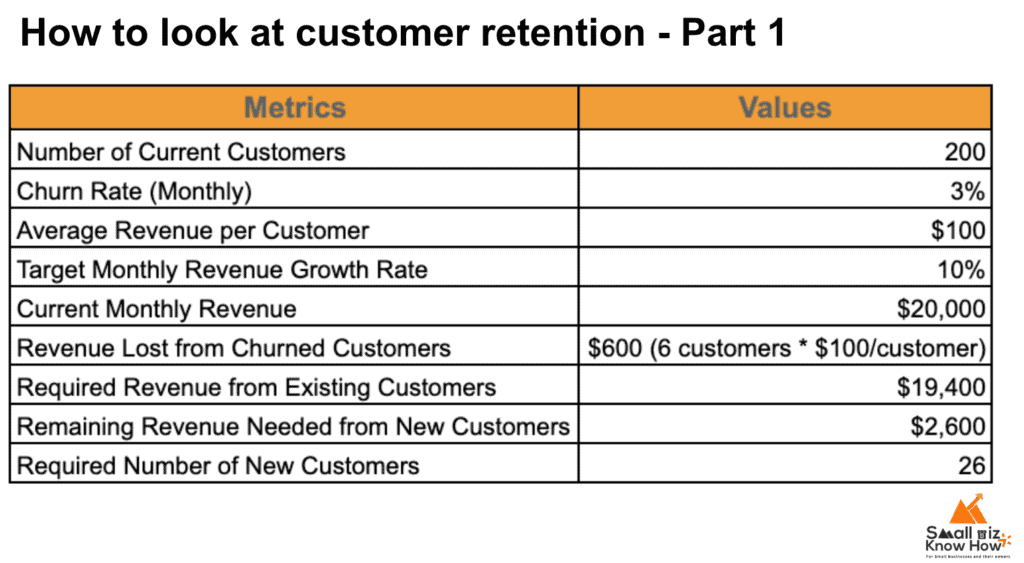
The remaining revenue needed to reach the target is what needs to come from new customers: Required Revenue from New Customers = Target Monthly Revenue – Required Revenue from Existing Customers Required Revenue from New Customers = $22,000 – $19,400 = $2,600
Now, let’s calculate how many new customers are needed to generate the required revenue: Required Number of New Customers = Required Revenue from New Customers / Average Revenue per Customer Required Number of New Customers = $2,600 / $100 = 26 new customers per month
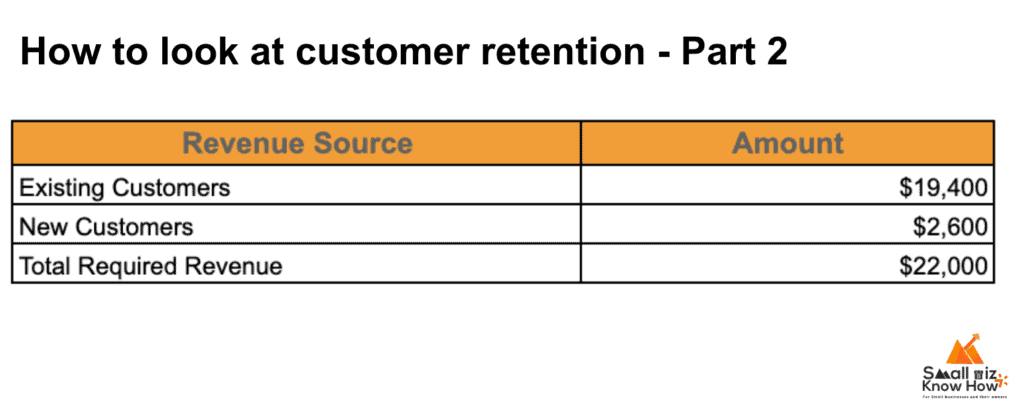
Therefore, in this scenario, the business would need to add approximately 26 new customers each month to maintain at least a 10% revenue growth rate while accounting for a 3% monthly churn rate.
This calculation underscores the importance of balancing customer acquisition with retention efforts in sales planning for businesses with repeat customers. By focusing on strategies to reduce churn and attract new customers, businesses can sustainably grow their revenue and build long-term customer relationships.
Strategies for Effective Sales Planning in Repeat-Customer Businesses:
- Customer Success Integration: Align sales strategies with customer success initiatives to ensure long-term satisfaction and retention.
- Upsell and Cross-sell Tactics: Develop clear plans for introducing existing customers to new products or upgraded packages.
- Churn Reduction: Implement proactive strategies to identify at-risk customers and address their concerns before they choose to leave.
Impact of a good sales plan on driving revenue
A well-crafted sales plan has a direct and profound impact on a company’s revenue. By setting clear goals, aligning team efforts, and meticulously planning marketing and sales activities, businesses can significantly enhance their sales performance and revenue growth.
How Sales Plans Drive Revenue:
- Goal Alignment: Ensures that every member of the team understands their role in achieving the company’s revenue targets.
- Efficiency Optimization: By identifying the most effective sales and marketing strategies, companies can allocate resources more efficiently, boosting ROI.
- Market Adaptation: Continuous analysis and adaptation of the sales plan based on market trends and customer feedback help in maintaining a competitive edge.
Sales plans also facilitate accountability and performance tracking, enabling businesses to identify strengths and areas for improvement within their sales teams. Moreover, a well-structured sales plan fosters innovation by encouraging experimentation with new sales techniques or technologies, driving continuous growth.
Additionally, effective sales planning involves collaboration between sales, marketing, and other departments, fostering a holistic approach to revenue generation.
Basically, sales plans empower businesses to proactively address challenges such as market disruptions or changing customer preferences, ensuring long-term sustainability and resilience in an ever-evolving business landscape.
How your sales plan can become a central execution plan for your business and dictate budget allocations, spending, growth rate
Transforming your sales plan into the central execution plan of your business allows for strategic alignment of budget allocations and spending, ensuring that financial resources are optimized to support growth initiatives.
Integration of Sales Plan with Business Strategy:
- Budget Alignment: Align budgeting with strategic sales targets to ensure financial resources are effectively used to support growth.
- Resource Allocation: Decide how to allocate human and capital resources across projects to maximize sales outcomes.
- Growth Forecasting: Use the sales plan to predict and plan for growth, adjusting strategies as needed to meet changing market conditions.
Lets look at an example where we convert a high level sales plan to the actual profit and loss statement for a business. This is just an illustrative exercise to highlight the concept of how this can be executed. Each business has its own nuance and this needs to be customised for every scenario.
Lets first look at how a typical sales team structure looks like for a small business

Monthly Sales Targets Calculation
Sales Executives: $10,000 per rep * 5 reps = $50,000 Account Managers: $15,000 per rep * 3 reps = $45,000 Total Monthly Sales Target = $50,000 + $45,000 = $95,000
Lead Generation and Conversion Calculation
Sales Executives: 100 leads * 10% conversion = 10 sales Account Managers: 50 leads * 20% conversion = 10 sales

Now lets look at how all of this which is a part of the sales plan can translate into a rough P&L for the business
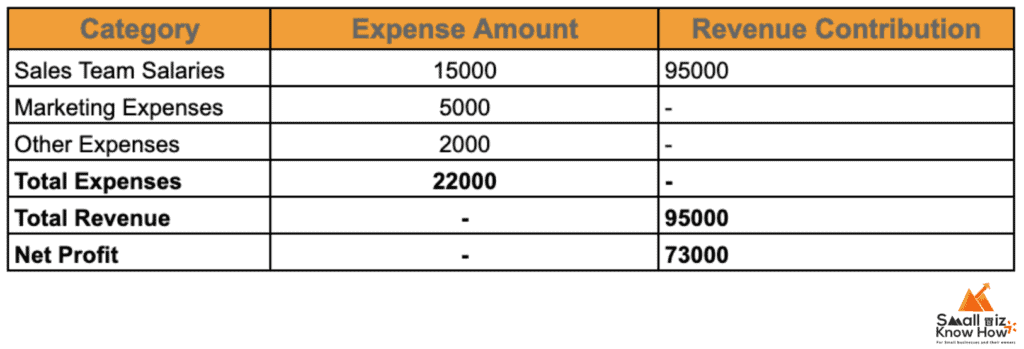
In the above sales plan, we’ve calculated monthly sales targets, lead generation, conversion, resource requirements, and integrated them into a Profit and Loss statement.
This provides a clear roadmap from sales planning to financial projections, ensuring strategic alignment and visibility into the financial health of the business.
How should your sales process fit into your sales plan
The sales process is a critical component of the overall sales plan, providing a roadmap for converting leads into customers. Effective integration of the sales process into the sales plan ensures a seamless flow from lead generation to closing sales, maximizing efficiency and effectiveness.
Effective Integration Strategies:
- Process Alignment: Ensure that the sales process aligns with the overall objectives of the sales plan, enhancing the team’s ability to meet set goals.
- Training and Development: Regular training sessions to keep the sales team updated on the best practices and tools used in the sales process.
- Continuous Improvement: Regular review and refinement of the sales process based on performance data and feedback from the sales team.
Integration of Sales Plans with Sales Processes:
Sales plans play a pivotal role in shaping and optimizing sales processes within an organization. They provide a strategic framework that guides how leads are generated, nurtured, and ultimately converted into customers.
One example that illustrates this integration effectively is the approach taken by Salesforce, a leading CRM platform provider. Salesforce aligns its sales plan with a well-defined sales process that includes stages such as lead qualification, opportunity management, and deal closure.
This alignment ensures that sales reps understand the steps involved in the sales cycle and can effectively move prospects through each stage, ultimately driving higher conversion rates and revenue growth.
Training and Development for Process Optimization:
Another crucial aspect of integrating sales plans with sales processes is ongoing training and development. Businesses that prioritize continuous learning and skill development empower their sales teams to execute the sales process with precision and effectiveness.
For instance, companies like HubSpot invest significantly in sales training programs that cover topics such as consultative selling, objection handling, and effective communication strategies.
By equipping sales reps with the right skills and knowledge, these businesses enhance the execution of their sales plans and achieve better results in terms of customer acquisition and revenue generation.
Continuous Improvement through Data Insights:
Moreover, successful integration of sales plans with sales processes involves a culture of continuous improvement driven by data insights. Analyzing performance metrics, conversion rates, and customer feedback provides valuable insights that can be used to refine and optimize the sales process.
Take, for example, a software-as-a-service (SaaS) company that regularly analyzes data from its sales pipeline. By identifying bottlenecks or areas of inefficiency in the sales process, the company can make data-driven decisions to streamline workflows, improve lead conversion rates, and ultimately drive higher revenue.
In conclusion, the effective integration of sales plans with sales processes is essential for achieving sales success and driving business growth. Businesses that align their sales objectives with a well-defined sales process, prioritize training and development, and leverage data-driven insights for continuous improvement are better positioned to capitalize on sales opportunities and outperform competitors in today’s dynamic market landscape.
